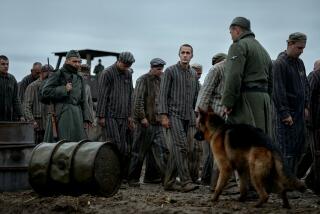War’s forgotten casualty: art
- Share via
When people think about World War II, wondering what it meant for the fate of museum-quality art is probably not the first thing that comes to mind. Yet as the documentary “The Rape of Europa” demonstrates, this is a surprisingly vast and involving topic.
Written, produced and directed by Richard Berge, Bonni Cohen and Nicole Newnham and based on the authoritative book of the same name by Lynn H. Nicholas, “Europa” covers a lot of territory and is packed with information.
It also tells a series of wonderful stories, many of which are fascinating enough to inspire movies of their own.
That art was on the World War II agenda at all is because of the unexpected makeup of German leader Adolf Hitler. As a young man he was eager to be an artist, but being turned down by the Academy of Fine Arts Vienna left him with a fierce hatred of modern art. That led, once he took power, to an “unrelenting war of purification” against what he considered degenerate art, a wholesale removal of 16,000 works from museum walls.
But Hitler didn’t just purge all he hated, he also stole what he coveted, which was a lot. And his passion for art mandated a parallel passion in his subordinates; Hermann Goering, for instance, had 1,700 paintings, more than most museums, at his country estate. This led to industrial-strength looting of occupied countries, a plundering so systematic that German bureaucrats made up lists of desired artworks as part of their invasion plans.
Some of the most interesting stories in “Europa” have to do with how Paris’ Louvre reacted to the impending invasion of France. Almost everything that could be moved, including the large and fragile Winged Victory of Samothrace, was carted up and sent out of town in a convoy of some 300 trucks. Specific curators were assigned specific works of art to look after, and the daughter of the couple assigned the Mona Lisa tells of how it was transported in a specially sealed ambulance.
Once the Germans occupied Paris, things got more complex. Rather than go after what the French had hid, the Germans looted art from Jewish apartments. Before being shipped back to Germany, the paintings were stored in the Jeu de Paume, where a woman named Rose Valland kept clandestine records of each painting, records that were essential in recovering the art after the war.
Aside from art, the Germans also confiscated furniture, and the story is told of a prisoner in Auschwitz, detailed to help ship the furniture to Germany, who was shocked to come across his own family’s household goods, including personal photographs, among the prizes of war.
For the invading American troops, how to treat historically and artistically significant buildings during attacks became such a major issue that a presidential commission was appointed to look into it and ruled that these structures should be saved whenever possible.
A famous test case where this was not done was the 1944 battle around Italy’s Monte Cassino monastery, an ancient site destroyed by American bombers because of fears that Germans were dug in inside. After the deed was done, German newsreels showed footage of the damage and accused the Americans of being “desecraters of European culture.”
“The Rape of Europa” details all these absorbing stories and more, even going into the postwar fights about who owns what painting that culminated in the sale of Gustav Klimt’s Portrait of Adele Bloch-Bauer I for a record $135 million.
The picture painted by this film is not pretty, but it is a difficult one to turn away from.
--
“The Rape of Europa.” No MPAA rating. Running time: 1 hour, 57 minutes. In limited release.
More to Read
The biggest entertainment stories
Get our big stories about Hollywood, film, television, music, arts, culture and more right in your inbox as soon as they publish.
You may occasionally receive promotional content from the Los Angeles Times.











